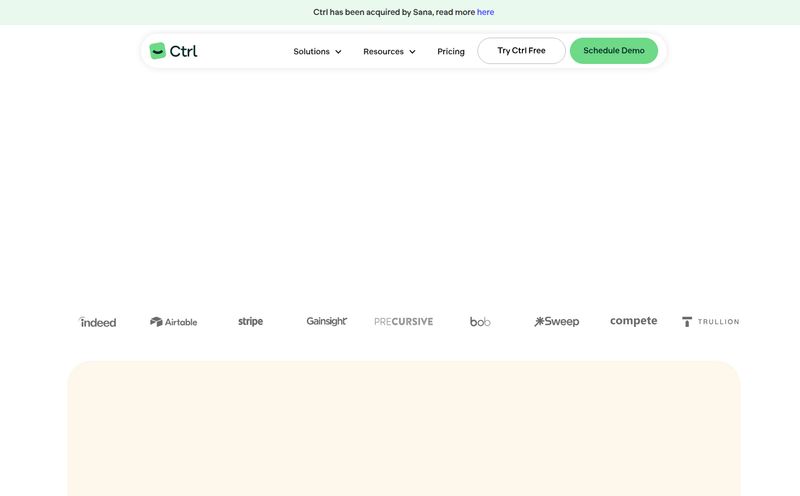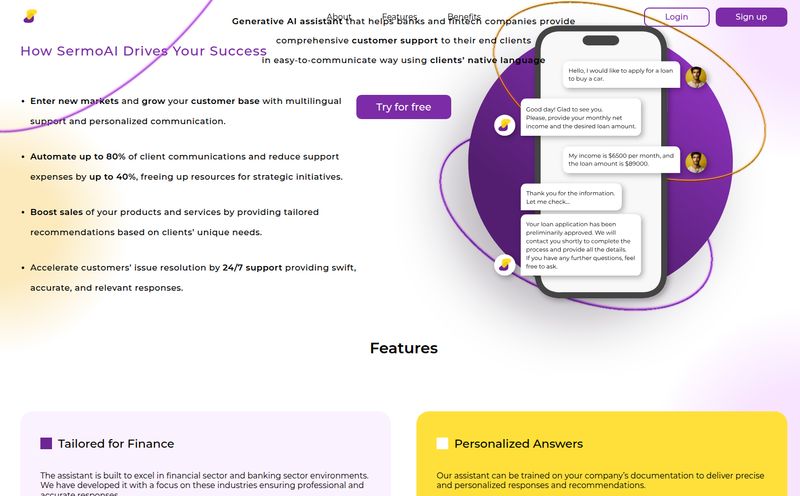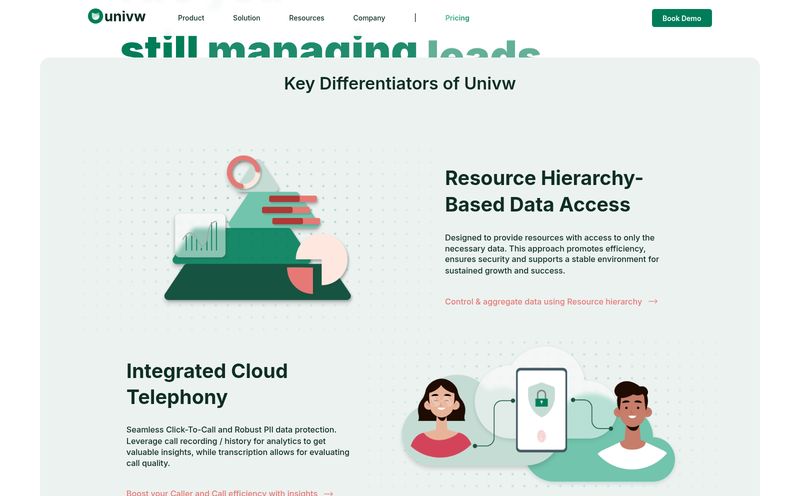The world of data science and AI can feel... a bit much sometimes. We're constantly talking about scaling pipelines, managing complex dependencies, and writing scripts that look more like ancient hieroglyphs than code. For years, building a sophisticated data workflow was like trying to assemble a spaceship in your garage. You needed a team of PhDs, a mountain of cash, and a whole lot of patience.
I've been in the trenches of SEO and traffic generation for a long time, and I've seen how powerful data can be. But I've also seen how a brilliant idea can die on the vine simply because the technical hurdles were too high. So whenever a tool comes along promising to democratize all this complexity, my ears perk up. But my skepticism meter also goes into overdrive.
Enter Domino. Not to be confused with the pizza place or the other big data science platform, this is an open-source, no-code platform for creating AI and data workflows. The promise? To close the gap between your big idea and actually making it happen. No code required. Sounds too good to be true, right? Well, I decided to take a look under the hood.
So, What on Earth is Domino, Really?
Imagine you have a bunch of powerful, specialized tools. You’ve got a tool for pulling data from Twitter, another for cleaning it up, one for running it through a machine learning model, and a final one for sending you a report on Slack. Getting them to work together in the right order, at the right time, is the hard part. That's the workflow.
Domino is essentially the conductor of that orchestra. It gives you a visual, drag-and-drop interface where each of those tools is a block. You connect the blocks, set the rules, and hit 'Go'. It’s like building with data LEGOs. Instead of writing complex scripts to manage this process (which is what tools like Apache Airflow traditionally require), you’re drawing a map. A map that Domino then follows meticulously.
It's designed to let anyone—from data analysts to marketers to the curious CEO—build some pretty advanced stuff without having to become a full-time developer. It handles integrations with APIs, social media, generative AI algorithms, you name it. It’s an ambitious goal.

Visit Domino
A Look at the Core Features I Kicked the Tires On
Okay, the concept is cool. But what about the execution? Here’s what stood out to me as I poked around.
The No-Code Workflow Builder is the Main Event
The heart and soul of Domino is its graphical user interface (GUI). It’s clean, intuitive, and does exactly what it says on the tin. You can create and edit your workflows by dragging components onto a canvas. What's really clever is the ability to create reusable visual elements from code. So, if you do have a developer on your team, they can build a custom block (say, for a very specific internal API), and then everyone else can just drag-and-drop it into their workflows without ever seeing a line of code. That’s a fantastic bridge between the tech-savvy and the not-so-tech-savvy.
Real-Time Monitoring That Actually Works
There's nothing worse than a 'black box' process. You hit run and just... hope for the best. Domino tackles this head-on with real-time monitoring. You can see your workflow chugging along, which step is currently active, and if anything has failed. The reports are rich and genuinely useful for debugging. For an SEO guy like me who runs a lot of data scrapes and analysis, knowing immediately when a scraper hits a wall is invaluable. It saves hours of frustration.
It Plays Nice with Others (Collaboration is Key)
Data projects are rarely a solo sport. Domino seems to get this. It’s built for teams. You can share workflows, comment on different steps, and see what your colleagues are building. This collaborative spirit extends to the community. Since it’s open-source, the idea is that people will share their custom-built blocks and workflows, creating a public library that everyone can benefit from. It's a great vision, though the success of that always depends on how active the community becomes.
The Good, The Bad, and The Open-Source Reality
No tool is perfect, especially not in the fast-moving world of AI and data. Here’s my honest breakdown.
The Things I Genuinely Love About It
First off, the price. It's open-source and free. That’s huge. It lowers the barrier to entry to basically zero. You can download it, spin it up, and start experimenting without getting a credit card out. I love that. Second, it's built on modern, serious tech. Being Kubernetes-native means it's designed to be scalable and resilient from the ground up. This isn't some flimsy weekend project; it's built to handle real work. The no-code interface is, of course, a massive plus, making it accessible to a much wider audience than traditional tools.
Some Important Reality Checks
Okay, let’s get down to brass tacks. The platform markets itself as "no-code," but I'd call it "low-code-ish." To get the most out of it, especially with complex data transformations, having some technical understanding of data workflows is a big help. It’s not a magic wand. You still need to understand the logic of what you’re building.
Another thing is its reliance on Apache Airflow. Airflow is an industry standard for workflow orchestration, which is great for power and reliability. However, it also means you’re inheriting some of Airflow's complexity and quirks. This isn't necessarily a bad thing, but it’s a dependency to be aware of. Finally, as with many open-source projects, community support can be a bit of a grab bag. You might find a solution to your problem in minutes, or you might be shouting into the void for a while. It’s the trade-off for not paying for enterprise-level support.
So, How Much Does Domino Cost?
This is the easy part. Zero. Zilch. Nada. Domino is free to use because it's an open-source project. You can go to their GitHub page, download the code, and install it on your own infrastructure.
Now, let's not be naive. "Free" doesn't mean zero cost. You will have to host it somewhere, which means paying for servers (e.g., on AWS, Google Cloud, or Azure). You’ll also need someone with the technical chops to set it up and maintain it. But the software itself? It's free, which is a breath of fresh air in a market filled with hefty subscription fees.
Who Should Actually Be Using Domino?
After playing around with it, I have a pretty clear picture of the ideal user. Domino is perfect for:
- Small to medium-sized data teams who want to standardize their workflow creation without enforcing a steep coding curve on everyone.
- Startups that need a powerful, scalable data orchestration tool without the enterprise price tag.
- "Citizen Automators"—data-savvy marketers, analysts, and ops people who understand logic and data flow but aren’t hardcore programmers.
- Hybrid teams where developers can build the complex, reusable components, and other team members can then use those components to build their own workflows.
It's probably not for the complete beginner who has never thought about an API or a data structure before. And it might not be for the massive enterprise that needs 24/7 dedicated, white-glove support and has an army of engineers to build custom solutions from scratch.
Final Verdict: Is Domino Worth Your Time?
Yes. Absolutely. For the right person or team, Domino could be a fantastic addition to the tool stack. It strikes a really interesting balance between the user-friendly, no-code world of tools like Zapier and the raw power of developer-centric orchestrators like Airflow. It’s an ambitious project that genuinely tries to make a complex field more accessible.
It’s not perfect, and the "no-code" label comes with a few footnotes. But the fact that it's open-source, built on a solid foundation, and focused on collaboration makes it incredibly compelling. It’s a tool that respects both the developer and the domain expert, and that's a rare and wonderful thing in my book.
Frequently Asked Questions About Domino
- Is Domino really free?
- Yes, the Domino software itself is 100% free and open-source. You will, however, need to cover the costs of hosting it on your own servers or a cloud provider like AWS or Google Cloud.
- Do I need to know how to code to use Domino?
- Not necessarily. For building basic workflows with existing components, you don't need to code. However, a good understanding of data logic is very helpful, and to create new, custom components, you or someone on your team will need programming skills.
- How is Domino different from a tool like Zapier?
- Think of it as Zapier on steroids for data science. While Zapier is excellent for connecting web apps (e.g., "when I get a new email, add a row to Google Sheets"), Domino is built to handle much more complex data processing, including large datasets, machine learning models, and intricate, multi-step data pipelines.
- Is this the same as Domino Data Lab?
- No, they are different products! This can be confusing. The tool discussed here is Domino Workflows (domino-workflows.io), an open-source workflow orchestrator. Domino Data Lab is a separate, commercial enterprise platform for data science. Make sure you're looking at the right one!
- What is Apache Airflow, and why is it important for Domino?
- Apache Airflow is a very popular open-source platform used to programmatically author, schedule, and monitor workflows. Domino uses Airflow as its powerful engine under the hood, but provides a user-friendly, no-code graphical interface on top of it.
- Where can I get support if I run into problems?
- As an open-source project, the primary support channels are community-based. This typically includes documentation, community forums, and a GitHub issues page where you can report bugs or ask questions to the community and developers.
Reference and Sources
- Domino Workflows Official Website: https://domino-workflows.io/
- Apache Airflow: https://airflow.apache.org/



